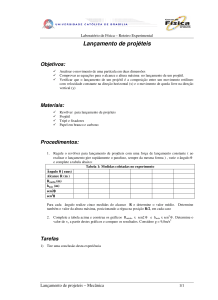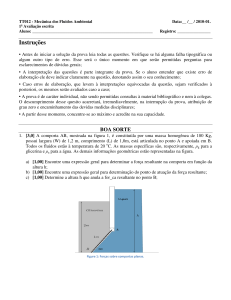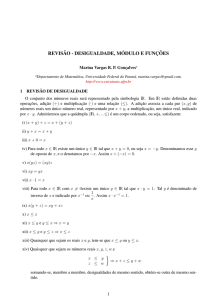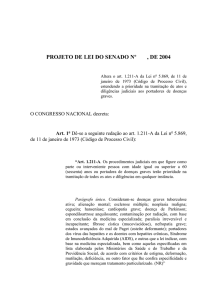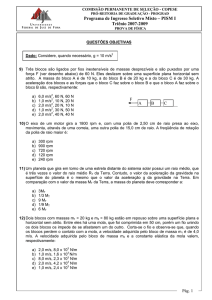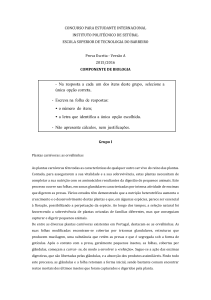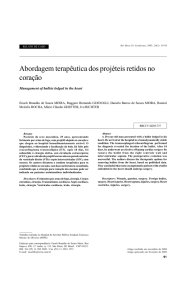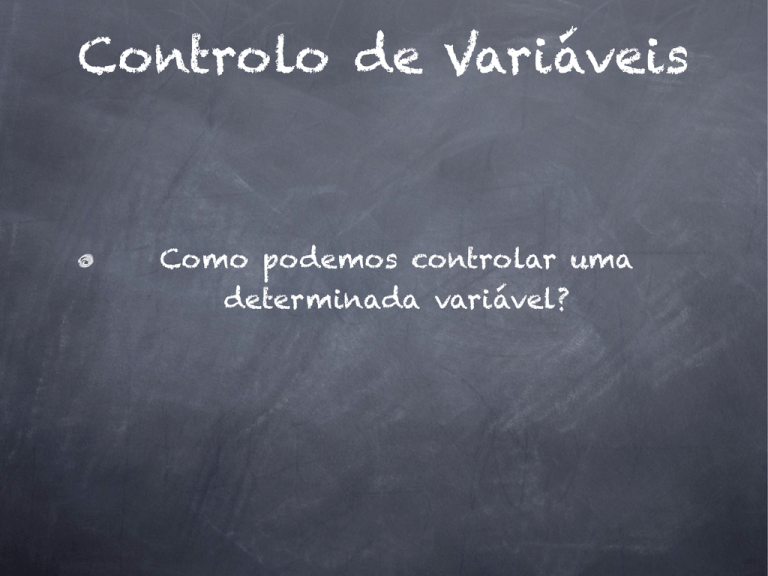
Controlo de Variáveis
Como podemos controlar uma
determinada variável?
Estudar a
variável v0,
mantendo a
variável
ângulo
controlada
Intensidade de v0
/ ms-1
Ângulo / º
Alcance (x) / m
altura max. ( h
max) / m
10
10
?
?
20
10
?
?
30
10
?
?
20
20
?
?
20
45
?
?
20
60
?
?
Estudar a variável
ângulo, mantendo
a variável v0
controlada
y(m)
150
vi = 50 m/s
75°
100
60°
45°
50
30°
15°
50
100
150
200
250
x(m)
Active Figure 4.11 A projectile launched from the origin with an initial speed of
50 m/s at various angles of projection. Note that complementary values of !i result in
the same value of R (range of the projectile).
Qual a grandeza que é controlada?
At the
http://www
vary the pro
serve the e
and measu
Qual a grandeza que está a variar?
Quick Quiz 4.6
Rank the launch angles for the five paths in Figure 4.11 with
respect to time of flight, from the shortest time of flight to the longest.
Pretende-se estudar o comportamento de que
grandezas?
P R O B L E M - S O LV I N G H I N T S
Movimento de Projéteis
Movimento em 2 Dimensões
ures link
om, you
ngle and
also obompog the trale.
y
vy
at the
Prevention
m that the
ojectile at
its trajectake arises
ween zero
ro accelere were to
leration at
n its velocwould not
ile would
t constant
This does
he acceleranywhere
g
vx i
#
$
θ
vi
NTION
v
vy = 0
vy i
!
"
vx i
vy
vx i
θ
v
θi
%
vx i
vx i
x
θi
vyi
Active Figure 4.7 The parabolic path of a projectile that leaves the origin with
a velocity vi. The velocity vector v changes with time in both magnitude and
direction. This change is the result of acceleration in the negative y direction.
The x component of velocity remains constant in time because there is no acceleration along the horizontal direction. The0
y component of velocity is zero at
the peak of the path.
v
como se caracteriza a
velocidade inicial, v : como se caracteriza o
na horizontal?
movimento: e
na vertical ? and using yi ! 0 and ay ! " g, we obtain
Repeating with the y component
na
vertical?
yf ! vyit & 12a yt 2 ! (vi sin #i)t " 12gt 2
(4.12)
e na horizontal
Next, from Equation 4.11 we find t ! xf/(vi cos #i) and substitute this expression for t ?
into Equation 4.12; this gives
Movimento de Projéteis
Direção vertical - a intensidade e sentido
do vector velocidade variam no tempo esta variação resulta da aceleração da
gravidade
Direção horizontal - o vector velocidade
mantém-se constante - não há aceleração
nesta direção
Movimento de Projéteis
O lançamento de um
projétil é uma
composição de dois
movimentos
movimento
uniforme, na
direção horizontal
movimento
uniformemente
variado, na direção
vertical
Movimento de Projéteis
Direção
Direção
horizontal
vertical
(eixo xx’)
(eixo yy’)
ax = 0
ay = g
v0x = v0 cosα
v0y = v0 senα
x = x0 + v0x t
y= y0 + v0yt + 1/2 ayt2
Movimento de Projéteis
Trajetória
dependente de
velocidade inicial
a=g
intensidade
Direção
ângulo
com a
horizontal
Movimento de Projéteis
Lançamento horizontal
Existe velocidade inicial nas duas
dimensões x e y?
v0x = v0
v0y = 0
Qual a velocidade em função do tempo
ao longo da trajetória para as duas
dimensões x e y?
vx(t) = v0
vy (t) = -gt
Estratégias para resolver
problemas de movimento
de projéteis:
Definir o eixo de coordenadas e representar
velocidade inicial em função de x e de y.
Estudar o movimento na componente
horizontal - aplicando as leis do movimento
uniforme
Estudar o movimento na componente vertical
- aplicando as leis do movimento
uniformemente acelerado
A plane drops a package of supplies to a party of explorers,
as shown in Figure 4.15. If the plane is traveling horizontally
at 40.0 m/s and is 100 m above the ground, where does the
package strike the ground relative to the point at which it is
released?
Problema:
Solution Conceptualize what is happening with the assistance of Figure 4.15. The plane is traveling horizontally
when it drops the package. Because the package is in freefall while moving in the horizontal direction, we categorize
Um avião que se desloca na
direção horizontal, 100 m
acima do solo e com uma
velocidade de 40 m/s, larga
uma saco de mantimentos
para dois exploradores que
se encontram a trabalhar no
local.
Qual será o alcance do saco
relativamente ao ponto em
que foi lançado?
y
40.0 m/s
x
this
we c
whic
Cons
able
is xf
pack
pack
I
grou
trave
equa
We k
y coo
verti
caus
zont
F
100 m
S
for t
Figure 4.15 (Example 4.6) A package of emergency supplies is
dropped from a plane to stranded explorers.
The
poin
drop
It hi
belo
tant
Worl
Example 4.7 The End of the Ski Jump
A ski-jumper leaves the ski track moving in the horizontal direction with a speed of 25.0 m/s, as shown in Figure 4.16.
From
jump


